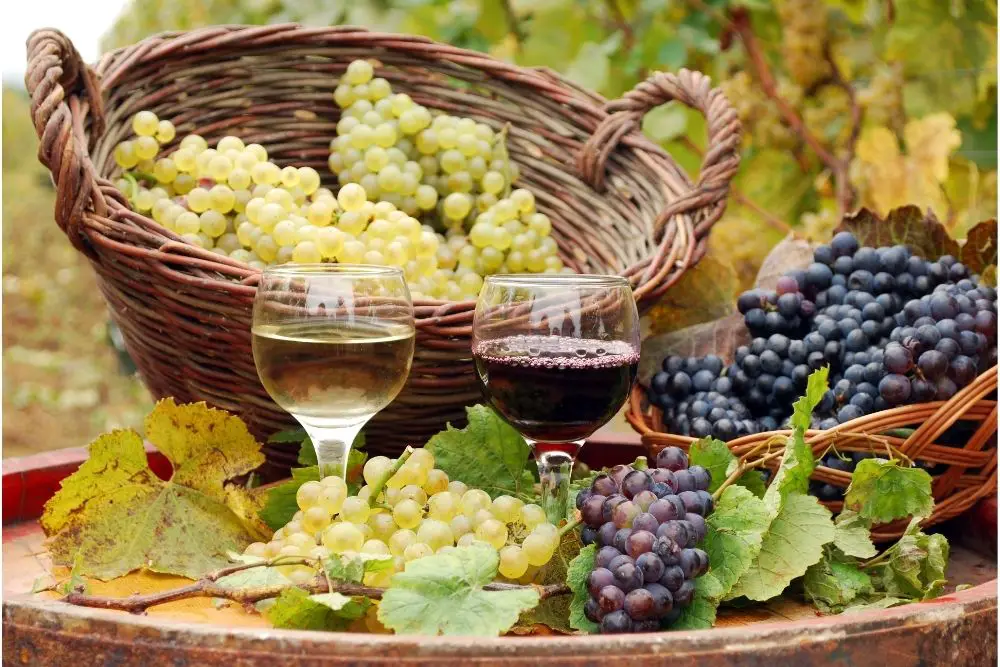If you’ve never made homemade wine, you may think it’s an incredibly lengthy process that takes a lot of ingredients.
However, if you’re wanting to make homemade wine you might be wondering: How do you make grape wine without yeast?
In this article, I will provide you with some key information about making wine alongside a step-by-step guide on how to make grape wine without yeast.
Keep reading to find out more.

Gold Medal Wine Club - Boutique, award-winning wines delivered monthly! → Choose Your Wines
What Is Yeast?
Yeast is a single-celled fungi called Saccharomyces cerevisiae and is a fundamental ingredient in several recipes.
There are two kinds of yeast. One is known as brewer’s yeast and the other as baker’s yeast. Baker’s yeast can be used for multiple purposes, including as a leavener for bread, while brewer’s yeast is used to help the fermentation process in wine making and beer production.
What Is The Role Of Yeast In Wine?
When there is an absence of oxygen, yeast starts to convert the sugars found in wine grapes into alcohol and carbon dioxide. This process is known as “fermentation”. If you’re confused about how fermentation can occur without adding yeast to wine, then look no further.
The fact is that you don’t need to add additional yeast can make wine, but yeast is a necessary component in winemaking. As I mentioned above, yeast plays a vital role in the fermentation process of making alcohol and is also traditionally a vital part of making wine.
Can You Make Wine Without Yeast?
No, you can’t make wine without yeast. The difference between grapes and wine is that a yeast consumed the sugar in the grapes and produced alcohol and carbon dioxide.
However, this doesn’t mean that grape wine is impossible to make without additional yeast. This primarily comes down to the fact that the majority of fruit has a layer of natural yeast on them which is well suited for the natural fermentation of wine.
When grapes are harvested in the vineyard, they are covered with a myriad of biological organisms, including yeast. As you begin to crush the grapes, the sugary grape juices mix with the yeast on the surface of the grapes and react, starting the natural fermentation process.
Some winemakers produce wines this way, calling it a “native” or “wild” or “natural” fermentation. However, it can be tricky and doesn’t always work, depending on what kind of and how much native yeast you have.
Why Is Using Grapes The Best For Wine Without Yeast?
Grapes are often used in the winemaking process due to the large amount of natural yeast which is on the grapes surface.
It’s fairly simple to make. All you need to do is check on your wine and stir it every day for a couple of weeks. The result is a beautiful grape juice that has fermented and can be bottled up and aged to turn into delicious wine for you and your friends to enjoy with dinner!
If you’re intrigued to try out making your own homemade grape wine without yeast, check out the recipe below.

A Guide On How To Make Grape Wine Without Yeast
Equipment That You Will Need:
- A large glass jar
- A piece of cheese cloth or something similar to cover the wine
- A large jug or carboy with a small mouth
- Wine bottles (Amazon)
- Corks
- Sanitizer
Ingredients:
- Grapes – The main ingredient required for this recipe is ripe grapes. You will need to ensure that you refrain from washing them, as this will get rid of the natural yeast that you need for a successful fermentation process. If you wash your grapes, it is more than likely that you will end up spoiling your batch of wine as it needs the natural yeast.
- Sweetener (Optional) – Honey or sugar. If your batch of grape juice is struggling to ferment naturally, you can add some honey or sugar to help the yeast a little alongside giving the wine a sweeter taste. It’s a win-win situation!
Instructions:
- Step one – To begin, you are going to need to sanitize the equipment before you get started. This is important to ensure you have gotten rid of any bacteria that could ruin the batch of wine. Otherwise, your hard work could likely be wasted!
- Step two – Next, it’s time to gather your grapes and place them inside a glass jar.
- Step three – Now you need to crush the grapes with your hands or utensils of your choice that will work efficiently to crush the grapes and retrieve as much juice as possible. Crushing breaks grape berries and this allows the juice, pulp, and seeds to infuse with the skins and stems. It’s normal for this process to take a while, so be patient, it will be worth it in the end!
- Step four – Once the grapes have been completely crushed, you can add in the sweetener if you wish. By mixing in several teaspoons of sugar or a naturally occurring sugar like honey, you will be able to aid the fermentation process. Once you have added your sweetener, stir to make sure that the sweetener is evenly distributed throughout the grape mixture. If you don’t want to add sweetener, skip this step.
- Step five – Next, you will need to transfer the grape mixture to a ceramic or glass container and cover it with a cheesecloth. You will need to make sure that you secure the cloth with a rubber band to secure it and to ensure that you protect the wine mixture as you leave it to ferment.
- Step six – Male sure that you stir the grape mixture 4 to 5 times per day for the first section of time. When bubbles start appearing, then you know the natural fermentation is currently ongoing. As a result of the ongoing fermentation process, you don’t have to stir the mixture more frequently than a couple of times a day.
- Step seven – Once the bubbling begins to slow down in the mixture, the fermentation process is nearly complete.
- Step eight – Next, you will need to place the grape mixture in a carboy. Here, you might want to sieve your grape skins from your mixture. However, when doing so you must make sure that you squeeze the grape skins to maximize the wine yield. You might decide to wait when it comes to sieving the skins, since removing them before you pour your wine into bottles can change the flavor and the color of your wine.
- Step nine – Place an airlock in the carboy’s opening. The airlock’s purpose is to allow carbon dioxide to escape while ensuring that no oxygen can affect the wine, as this can cause oxidation to occur that can spoil the whole batch.
- Step ten – Allow the mixture to sit in the carboy for a few weeks, and try the wine to see if you like it. If you don’t yet, allow the mixture to sit for another couple of days.
- Step eleven – At this stage, sieve the skins from the wine if you didn’t already do so before you placed the wine in the carboy. Pour the wine into wine bottles before corking each of them tightly.
- Step twelve – Let the bottles rest in a cool, dark place for a minimum of three months, but for the best results, you should wait up to a year. You will want to place the wine bottles somewhere with minimal sunlight, as this will allow the wine to age nicely without the sun interfering.
- Step thirteen – Enjoy the fruits of your labor!
Making wine at home without using yeast is very much a trial and error process, so try to not feel disheartened if it doesn’t work the first time around.
Making Homemade Grape Wine Without Yeast (Important Notes)
It’s crucial to understand that making wine and relying on the natural fermentation of grapes can be tricky. The process can take a few tries, and you shouldn’t feel discouraged if your wine doesn’t work the first time you attempt to make it.
If you’re not successful in creating a natural fermentation process, this could come down to two factors:
- Lack of natural yeast – You might have been unsuccessful if your grapes weren’t covered in enough natural yeast. This usually happens if the grapes have gotten wet or you washed them. When you make wine with natural yeast, it is imperative that you never wash the grapes beforehand as this will wash off the majority of it.
- Unripe grapes – If your grapes weren’t ripe enough, or too ripe, you might end up with the wrong sugar content. As a result of this, the yeast won’t have enough “food” to consume and turn into alcohol. Your wine could ferment, but the result could turn out to be tasteless, bland or bitter if you don’t get the ratio right. Bearing this in mind, you will need to use grapes that are ripe enough for the wine making process.
When it comes to making your own wine, it’s important to remember that patience is key! You don’t want to rush the wine, as it won’t taste as good. This is what makes the process so special!
